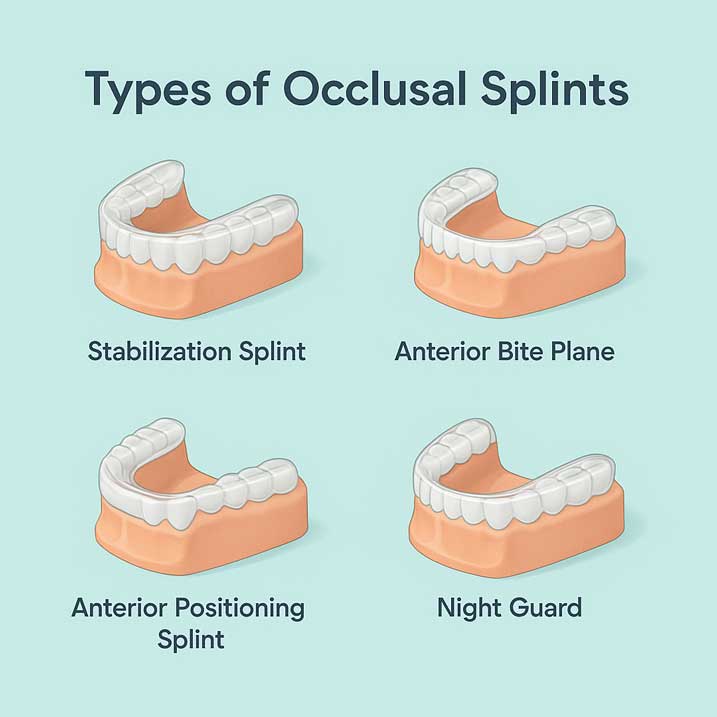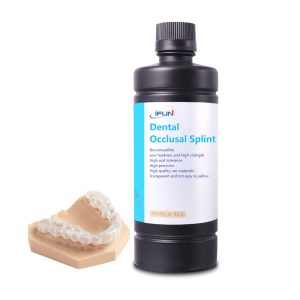Occlusal splints are vital tools in managing temporomandibular disorders (TMD), bruxism, occlusal discrepancies, and diagnostic treatments in restorative dentistry. As digital dentistry continues to evolve, 3D printing has become a powerful ally in manufacturing high-quality, custom-fitted splints. In this article, we’ll explore the different types of occlusal splints, their clinical applications, and how additive manufacturing is changing the way we produce them.

What Are Occlusal Splints?
An occlusal splint, also known as a night guard, bite splint, or dental splint, is a removable oral appliance designed to cover the occlusal surfaces of the teeth. It helps stabilize the jaw, protect the dentition, and supports various forms of therapy in TMD and occlusion management.
Types of Occlusal Splints and Clinical Goals
| Splint Type | Common Names | Common Indications | Clinical Purpose |
| Stabilization Splint | Michigan Splint, TMJ Stabilization Splint | TMJ disorders, bruxism, myofascial pain | Relieve muscle tension, reduce clenching, stabilize occlusion
|
| Anterior Bite Plane | Bite Plate | Acute muscle hyperactivity, early TMD management | Disengage posterior teeth, relax masseter muscles |
| Anterior Positioning Splint | Mandibular Repositioning Splint | TMJ disc displacement with reduction (clicking), jaw locking | Advance lower jaw to treat disc displacement or clicking |
| Night Guard | NTI Night Guard, Hard/Soft Night Guard | Sleep bruxism, tooth wear, tension headaches | Protect teeth from grinding or clenching during sleep |
| Soft Splint | Flexible Night Guard | Mild bruxism, patient compliance concerns | Increase comfort for mild bruxism or initial therapy |
| Dual Laminate Splint | Hard-Soft Splint | Moderate to severe bruxism, muscle-related TMD | Combine comfort and durability for moderate grinders |
| Overlay/Full-Coverage Splint | Reconstructive Splint | Full-mouth reconstruction, loss of vertical dimension, worn dentition | Used in full-mouth rehab or vertical dimension testing |
| Partial Coverage Splint | Segmental Splint | Diagnostic testing, localized occlusal adjustment | Adjust a specific region; usually used diagnostically |
Each splint type is indicated for specific TMJ dysfunctions, muscular issues, occlusal interferences, or protective therapy. For example, the Michigan Splint is one of the most commonly prescribed appliances for TMD stabilization, while the NTI Night Guard is a popular choice to minimize parafunctional forces at night.
How 3D Printing Is Transforming Splint Fabrication
Traditionally, occlusal splints were produced manually using heat-formed thermoplastics or milled PMMA. Today, resin-based 3D printing allows dentists and labs to create more precise, repeatable, and patient-specific devices at lower cost and faster turnaround times.
Advantages of 3D Printing for Occlusal Splints:
- Greater accuracyand anatomical adaptation
- Consistent thicknessand contact areas
- Streamlined workflow: from intraoral scan to delivery
- Material versatility(hard, soft, or dual-layer)
Matching Resin Properties with Splint Function
Each type of splint requires different material performance. Here’s a breakdown:
| Splint Type | Recommended 3D Printing Material | Key Resin Requirements |
| Stabilization Splint | Rigid, biocompatible clear resin (e.g. IFUN Occlusal Splint Resin) | High rigidity, clarity, long-term intraoral wear |
| Anterior Bite Plane | Hard transparent resin | Minimal warping, occlusal contact accuracy |
| Soft Splint | Elastic, flexible biocompatible resin | High elongation at break, comfortable wear |
| Dual Laminate Splint | Printed shell + hand-layered soft lining | Outer hardness + inner resilience |
| Overlay Splint | High-precision, long-span resin | Excellent edge stability and wear resistance |
| Night Guard | Hard or semi-flexible dental resin | Impact resistance, dimensional stability |
How long does a night guard last?
With 3D printed splints using high-quality resin, clinical durability can range from 6 months to 2+ years, depending on bruxism severity and material type.
Does night guard help with jaw shapes?
While night guards do not permanently alter jaw shapes, they help improve muscle positioning, disc alignment, and may reduce maladaptive postures when used with occlusal therapy.
Challenges in 3D Printing Occlusal Splints
Despite the benefits, several challenges remain:
- Soft materialsare difficult to print on standard LCD/DLP machines and require specialized flexible resins.
- Dual-layer splints(soft inside, hard outside) are difficult to fabricate in a single print and often require hybrid workflows.
- Fit accuracyis dependent on scanner resolution, bite registration precision, and printer calibration.
Thus, choosing the right dental 3D printer and Class IIa certified resin is critical for predictable outcomes.
Final Thoughts for Dental Professionals
For dentists and lab technicians, understanding the types of occlusal splints, their clinical indications, and how they interface with digital fabrication is key to elevating patient care. With 3D printing, clinicians can offer custom-fit, highly functional appliances faster and more economically than ever before.
Whether you’re treating a patient with chronic bruxism or repositioning a displaced TMJ disc, there’s a splint—and a digital workflow—that fits the case.
Ready to explore professional-grade 3D printing for occlusal splints?
We offer premium dental resins and high-precision LCD printers designed for restorative and TMJ applications. [Contact us] to request a sample or get clinical guidelines.

